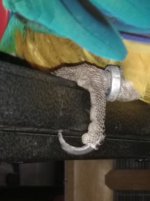Kentuckienne
Supporting Vendor
- Oct 9, 2016
- 2,747
- 1,648
- Parrots
- Roommates include Gus, Blue and gold macaw rescue and Coco, secondhand amazon
Gus is the first macaw I've known, so I don't know what's normal for them. He has a hunchback (kyphosis) as a result of poor nutrition when he was young. I am wondering what other parts of his body are affected. I notice that when he sits on any perch, he sits all the way down on the lower leg, back to the joint. Do these pictures look ok for a macaw? We are making different kinds of perches for his comfort and safety, so any information would be helpful for designing them.
Still trying to post an inline photo from the iPad, as there is no right-click....got it, had to change .html to .jpg



Still trying to post an inline photo from the iPad, as there is no right-click....got it, had to change .html to .jpg


Last edited:





